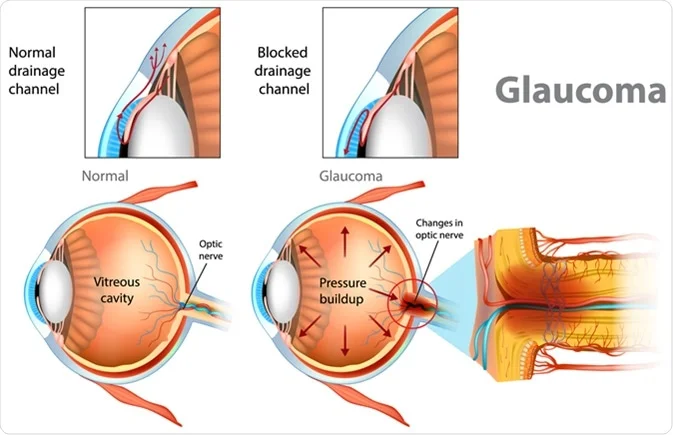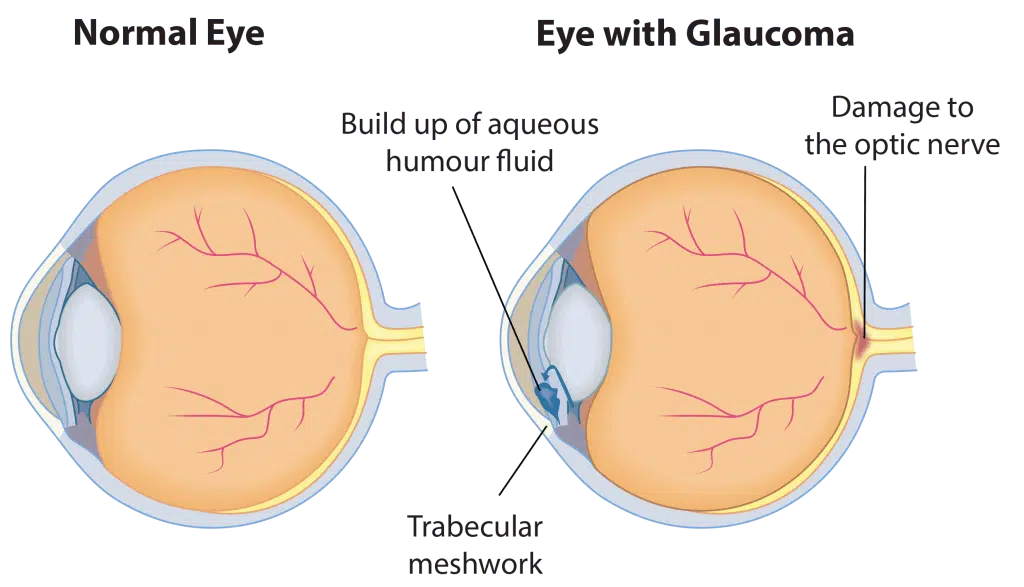
 Posted By Akio
Posted By Akio- Comments 0
Glaucoma, also known as “kala motia” occurs when the optic nerve which connects your eye to the brain gets damaged. This might lead to vision loss or blindness. It can be found in people of all ages but is most commonly seen among older adults.
Understanding what are the 4 types of glaucoma is crucial for early detection and effective management. In this blog understand what is Glaucoma and will break down its types:
The Types of Glaucoma:
Even though Glaucoma doesn’t show symptoms in the beginning, it is crucial to understand what are the 4 types of glaucoma to help in its early detection and treatment, before it leads to vision loss.
Four main types of Glaucoma are:
- Primary Open-Angle Glaucoma (POAG): This type of Glaucoma occurs most commonly, due to the build-up of intraocular pressure in the eye which affects the optic nerve. In this, you may not see any symptoms initially, but over time, you might get blind spots on the side of your eye, and problems seeing straight ahead. This Glaucoma can occur in one or both eyes.
- Angle-Closure Glaucoma (ACG): This type of Glaucoma is more serious and occurs when there’s a block in the passage where eye fluids get drained. This leads to high intraocular pressure and requires immediate medical treatment.
- Congenital Glaucoma: This type of Glaucoma is also known as newborn glaucoma, as it affects children who are born with enlarged eyes, due to incorrect development of their eye’s drainage system. The child may also experience sensitivity to light or cloudiness in the cornea.
- Secondary Glaucoma: This type of Glaucoma is when there is a rise in the intraocular pressure due to some primary ocular or systemic disease, such as Behcet’s disease, head injury, sickle cell disease, etc. This can lead to damage to the optic nerve and may even lead to vision loss. Like Primary Open-Angle Glaucoma, this can also occur in one or both eyes.

Can Glaucoma Be Prevented?
Unfortunately, not all types of glaucoma can be prevented. However, there are some solutions in terms of how to prevent glaucoma by lowering the eye pressure, such as:
- Maintaining a healthy diet
- Exercising regularly
- Keeping BP under control
- Avoid drinking and smoking
- Wearing protective eyewear
- Scheduling regular eye exams
Managing and Controlling Glaucoma
Even though glaucoma cannot be entirely cured, there are ways to lower the intraocular pressure which leads to glaucoma. Some common treatment options come with understanding what are the 4 types of glaucoma and their severity:
- Eye Drops: Eye drops are usually recommended first when it comes to Glaucoma treatment. This is because it helps in lowering eye pressure by improving fluid drainage from the eye.
- Prescription eye drops often include Prostaglandins, Beta-blockers, Alpha-adrenergic agonists, Carbonic anhydrase inhibitors, etc.
- Laser Surgery: For those who can’t tolerate eye drops, Laser Trabeculoplasty is another option that can help lower eye pressure by draining the fluid from the eye by creating new pathways to improve the flow of fluid. It helps in treating open-angle glaucoma
- Traditional Surgery: This type of surgery is known as Trabeculectomy, or filtration surgery, and is the most common option for the treatment of Glaucoma. In this surgery, a tiny hole is created in the white part of the eye known as the sclera, which creates a pathway for fluid drainage in the eye.
Addressing Common Concerns
Here are answers to some common concerns related to Glaucoma:
Can glaucoma be cured with eye drops?
Even though eye drops are the primary and common treatment for glaucoma, they can’t cure it entirely. However, using eye drops regularly can prevent glaucoma from getting worse, as they help lower the pressure in the eye.
Can glaucoma be treated with surgery?
Yes, both laser surgery and traditional surgery can be used in some cases to improve drainage and manage IOP.
Glaucoma surgeries like Trabeculectomy or Argon Laser Trabeculoplasty can certainly help lower the intraocular eye pressure as well, but can’t cure the glaucoma entirely. However, glaucoma surgery is often recommended to help sustain the remaining vision of the eye.
What are the first signs of glaucoma?
Even though there aren’t any signs in the initial stages of Glaucoma, it may show its development in different ways depending on its type:
- Open-angle Glaucoma: You might not notice anything at first. But over time, you might have blind spots on the side of your eye, and problems seeing straight ahead.
- Acute angle-closure glaucoma: You might experience sudden and intense headaches, eye pain, nausea, blurred vision, rainbow halos around lights, or red and irritated eyes.
- Normal-Tension Glaucoma: You might experience blurry vision, or lose peripheral (side) vision.
- Glaucoma in Children: This is less common. But a child may have a cloudy, dull-looking eye, and experience excessive blinking or tears.
- Pigmentary Glaucoma: You might see halos around lights, have blurry vision, or loss in your peripheral (side) vision.
If you have any of these symptoms, it is recommended to visit an ophthalmologist right away.

Can I drive if I have glaucoma?
People with moderate-advanced level Glaucoma are often advised against driving due to the following factors:
- Glaucoma affects the peripheral vision
- You might see glares
- You might experience poor vision during the night
- Your eyes might get sensitive around low contrasts
- Vision can be affected while driving from light to dark areas, such as tunnels
It is advised to schedule a consultation with your ophthalmologist for guidance.
Conclusion
Although Glaucoma is known to silently affect your vision without showing any symptoms initially, it can be managed with early detection and treatment. This can only be done through regular eye check-ups, and maintaining a healthy lifestyle, especially in the case of individuals suffering from conditions such as Diabetes, high blood pressure, migraine, or sickle cell anemia.
Understanding what are the 4 types of glaucoma can help in recognizing potential risks before your vision gets severely affected. Fortunately, there are various options for the treatment of glaucoma by lowering the intraocular pressure in the eye, which include eye drops, laser surgery, as well as traditional surgery. These processes can’t cure glaucoma entirely, but can still help you manage the quality of your vision.



